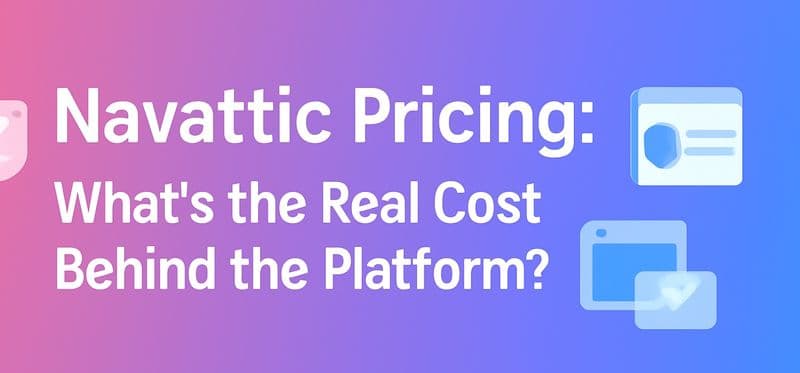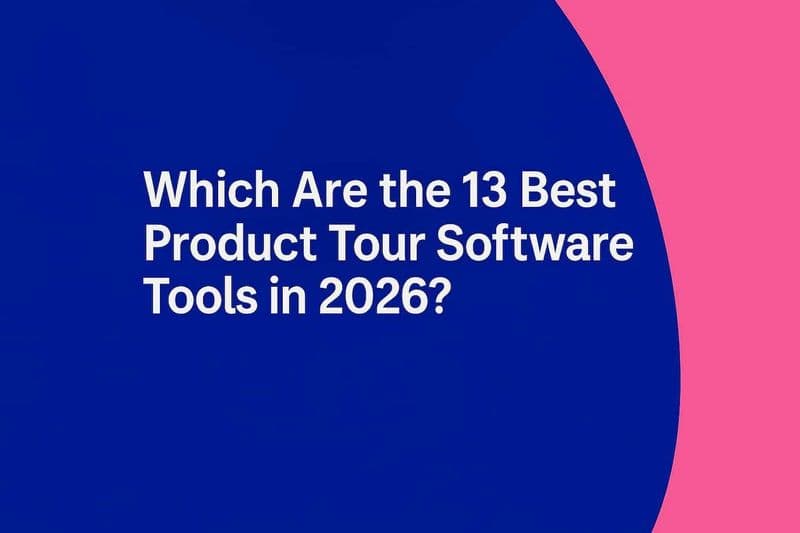
Launching a SaaS product isn’t just about going live; it’s about having a solid SaaS product launch strategy to hit the right goals, aligning teams, and avoiding missteps that cost time, users, and revenue. Yet, many teams dive into launches with scattered timelines, unclear responsibilities, and no clear framework to follow. The result? Missed opportunities, confused messaging, and products that fall flat.
This blog is for those who’ve felt the chaos of last-minute launch prep or the frustration of misaligned execution. Inside, you’ll find a SaaS product launch plan template designed to bring clarity, structure, and momentum to your launch, including valuable case studies. Whether you're introducing a new platform or rolling out a major update, this template offers a real-world approach to help your team move faster, stay synced, and launch with confidence.
What is a product launch plan?
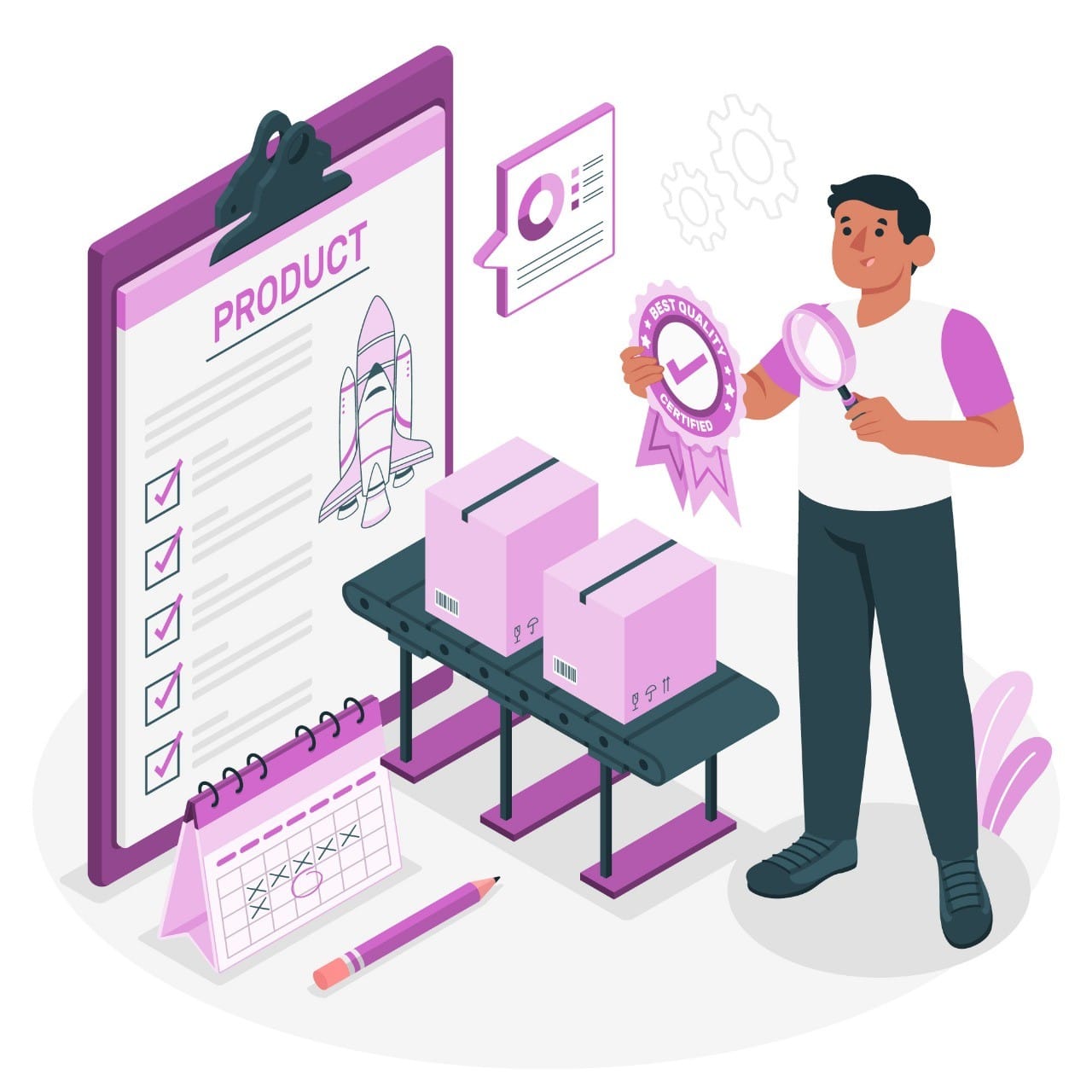
A product launch plan is a detailed roadmap that outlines how a company will introduce a new product to the general public in the market. It covers everything from internal preparation and messaging to timelines, team responsibilities, and marketing strategies. For SaaS companies, a launch plan helps align product, marketing, sales, and customer success teams to ensure a smooth rollout, consistent communication, and a strong first impression. Instead of winging it, teams use the plan to stay focused, track progress, and avoid last-minute chaos.
What are the three different product launch phases?
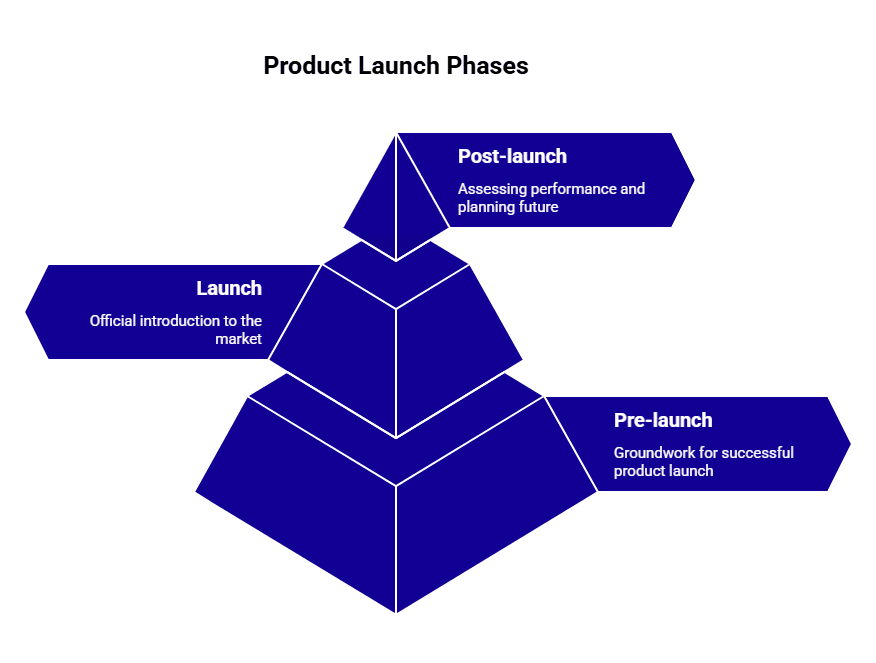
The product launch cycle can be broadly divided into three main phases. Each phase focuses on specific tasks that prepare your team, introduce the product to the market, and ensure continuous growth after release. Understanding and managing these phases carefully helps avoid last-minute chaos, aligns teams, and maximizes the product’s impact.
1 . Pre-launch phase
The pre-launch phase is all about preparation. It involves market research to understand your audience and competitors, finalizing your product features, and setting clear goals for the launch. During this phase, your marketing team develops messaging and promotional materials like blogs, emails, and social media campaigns content. Sales and customer support teams get trained on the product to handle inquiries confidently. You also plan your launch timeline, assign roles, and test all technical aspects to avoid glitches. This phase sets the foundation for a smooth launch by ensuring everyone is aligned and ready. Here's a breakdown of key tasks typically accomplished during the Pre-launch phase:
Tasks | Description |
|---|---|
Market Research | Understanding industry trends, market needs, and competitor strategies. |
Create User Personas | Visualizing target customers based on their characteristics and needs. |
Define Value Proposition | Articulating the unique benefits that your product offers. |
Set SMART Goals | Defining measurable objectives that the product launch aims to achieve. |
Develop a Marketing Plan | Crafting a detailed plan laying out marketing tactics, channels, and budget. |
Remember, sharp pre-launch activities lay the groundwork for all the victories you aim for during the product launch.
2. Launch phase
The launch phase is when the product goes live. Marketing campaigns are rolled out across channels to build awareness and attract users. Your team monitors performance closely, addresses customer feedback, and solves issues quickly. Communication with customers and stakeholders is crucial here to maintain excitement and trust. This phase focuses on gaining initial traction and setting the tone for the product’s success.
3. Post-launch phase
After the launch, the post-launch phase focuses on measuring results and optimizing performance. You analyze user behavior, gather feedback, and track key metrics like adoption rates and churn. Based on these insights, your team prioritizes updates, fixes bugs, and refines product marketing strategies. Ongoing customer engagement and support during this phase help build loyalty and drive growth beyond the initial release. Here's how to optimally leverage the post-launch phase:
Monitor campaign performance: Track the performance of your launch campaigns by comparing results against your initial goals. Identify which channels, messages, or strategies worked well—and where adjustments are needed to improve reach or engagement.
Collect user feedback: Actively seek feedback from your early users through surveys, interviews, or in-app prompts. Their input helps you uncover usability issues, feature gaps, or opportunities to refine the experience on platforms like Product Hunt.
Analyze customer behavior: Dive into usage analytics to understand how users are interacting with your product. Look for patterns in onboarding, feature adoption, and drop-off points to guide your next steps.
Prioritize retention: From day one, focus on keeping your users engaged. Develop retention strategies such as onboarding improvements, helpful content, or loyalty campaigns to reduce churn and build long-term value.
What different approaches are there for product launch plans?
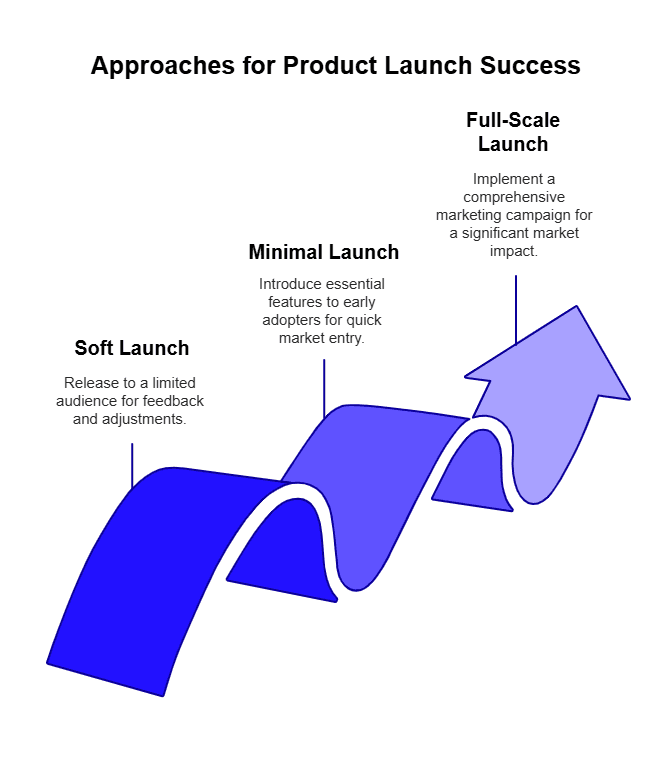
Not every product launch needs to be big and bold. Depending on your goals, team size, and product maturity, you can choose from a few common launch approaches: soft launch, minimal launch, beta launch, and full-scale launch. Each method serves a different purpose and suits different stages of your product lifecycle.
1. Soft launch plan
A soft launch introduces the product to a small, specific group of users. These could be beta testers, long-time customers, or a segment within your target market. Instead of chasing reach or downloads, the focus here is learning. You observe how real users interact with the product, identify unexpected issues, and assess whether the product is solving the problem it claims to.
This approach reduces risk because mistakes can be addressed quietly without damaging your reputation. It also helps test your internal workflows, including support, onboarding, and analytics, before opening the doors to a larger audience. Soft launches work well for SaaS startups looking to validate performance under low pressure or for new features within an existing product.
2. Minimal launch plan
A minimal launch gets the product out quickly with only the essential features and limited marketing. You are not trying to create buzz or fill up newsfeeds. Instead, you are quietly testing the waters to see what kind of response you get. This approach is especially useful when a product is still in its early form and the team wants feedback without building expectations they may not be ready to meet.
It often involves launching within your network, relying on early adopters or community exposure, and keeping efforts lean. There is no major spend on ads or PR, just a product that is live and open to users with a feedback loop in place. A minimal launch gives teams space to learn and adjust without the pressure of high visibility.
3. Full-scale launch plan
A full-scale launch is a high-effort, high-visibility release designed to make a strong market impact from the beginning. It includes coordinated efforts across product, marketing, sales, customer success, and engineering teams. Campaigns usually run across multiple platforms including emails, paid media, webinars, and product announcements.
This type of launch needs careful preparation. Your support team should be ready for a possible surge in inquiries, your onboarding experience must be smooth, and your product should be technically equipped to handle increased usage. Full-scale launches are best when the product is stable, has already been tested, and the aim is to gain significant traction quickly.
What are the steps to create a successful product launch plan?
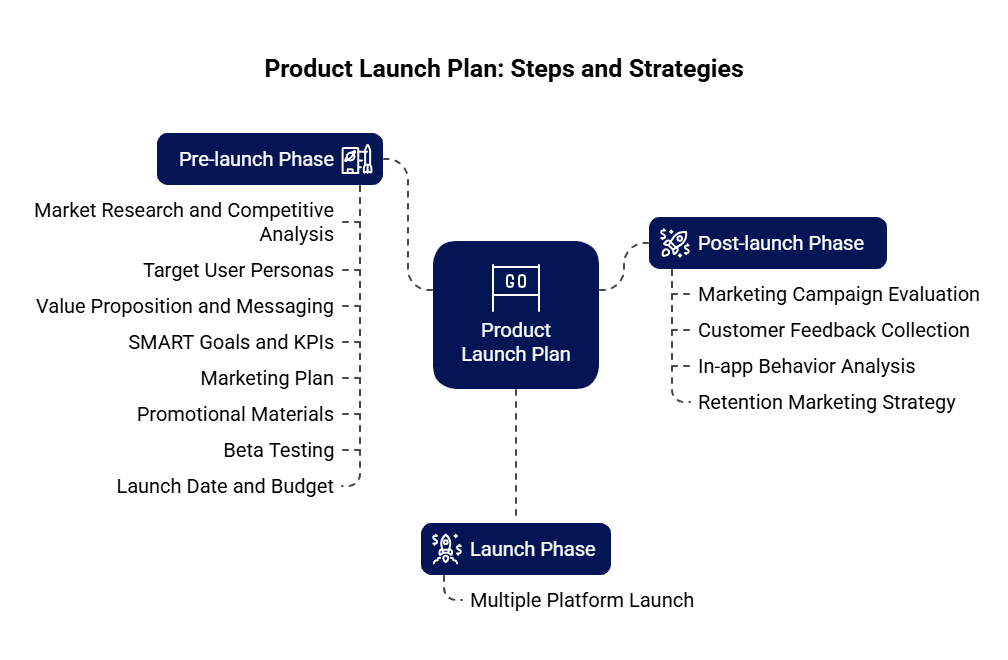
A well-executed product launch doesn’t happen overnight. It unfolds in phases — each with its own set of tasks, business goals, and challenges. From market research to retention, every step plays a role in shaping how your product enters the market and how users respond to it. Here's a breakdown of the key actions to take during each stage of the product launch process.
1. Pre-launch phase
This phase lays the groundwork. It’s where market strategy, research, and preparation come together to position your product for a strong debut.
Conduct market research and competitive analysis
Understand the current landscape. Identify who your competitors are, how they position their products, and where gaps or opportunities exist.Dig into your target user personas
Define who your ideal users are, what problems they face, and what motivates their decisions. This will influence everything from product features to marketing messages.Define your value proposition and develop a messaging strategy
Clearly articulate how your product solves a problem better or differently than alternatives. Build messaging that resonates with your audience across all touchpoints.Set SMART goals and tie them to key performance indicators
Your goals should be Specific, Measurable, Achievable, Relevant, and Time-bound. Link each one to trackable KPIs like sign-ups, conversions, or activation rates.Develop a product launch marketing plan
Plan your outreach. Decide which channels you'll use — email, social media, communities, or PR — and what kind of content or campaigns you’ll run.Create promotional marketing materials to generate buzz before the launch date
Design assets like teaser videos, landing pages, blog posts, and social content that build anticipation.Perform beta testing with beta users before the product launches. Invite a small group to try the product. Use their feedback to spot bugs, fix usability issues, and validate key features.
Decide on the launch date, timeline, and budget
Set a realistic timeline, allocate resources, and confirm internal and external schedules to ensure a smooth rollout.
2. Launch phase
This is the execution stage where your product finally meets the market.
Launch your product on multiple platforms
Announce your launch across all planned channels. Sync your internal teams to support traffic, user queries, and any unexpected glitches. Monitor in real-time and respond quickly.
3. Post-launch phase
Once the product is live, the focus shifts to improvement, retention, and scaling.
Evaluate the performance of your marketing campaigns
Measure outcomes against your original KPIs. Identify what worked, what fell short, and why.Collect customer feedback to improve your product
Reach out directly or use in-app surveys to gather insights that help guide future updates.Analyze in-app customer behavior for actionable insights
Study how users navigate the product. Spot drop-off points, feature usage trends, and engagement patterns to fine-tune user experience.Create a retention marketing strategy and focus on keeping the acquired customers
Develop onboarding flows, loyalty programs, and nurture emails to keep users engaged. It’s more efficient to retain users than to acquire new ones repeatedly.
The B2B Product Pre-Launch Checklist
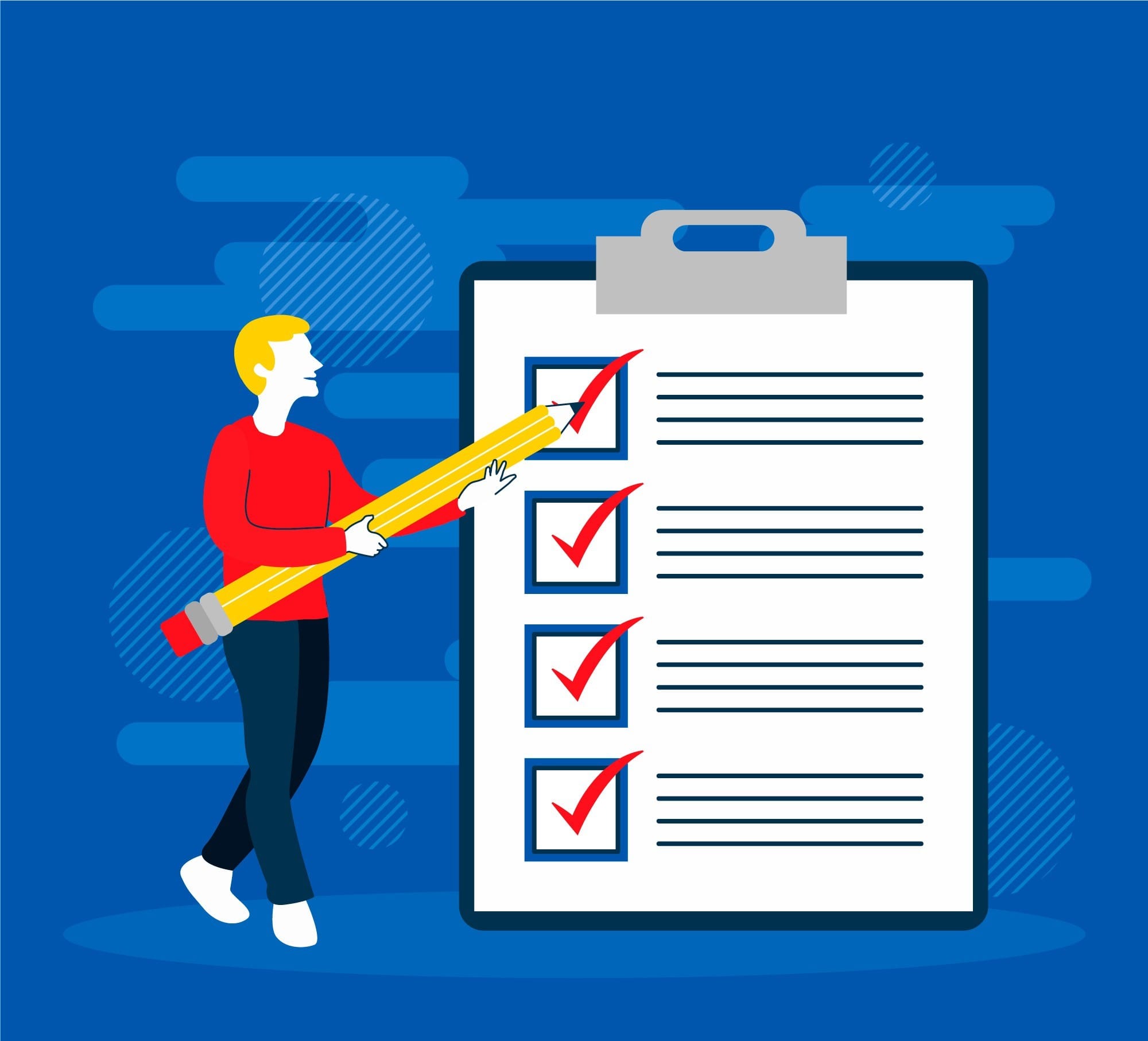
Before launching a B2B product, there’s a lot of groundwork that needs to be done. A well-planned pre-launch phase helps avoid surprises and sets your team up for success. This checklist will help make sure everything is in place before you go live.
1. Understand the Market
Start with thorough market research. Know who your competitors are, what they offer, and where your product stands out. This helps you position your product more effectively.
2. Define Your Audience
Clearly identify your target audience. Build user personas to understand their needs, challenges, and what they expect from a solution like yours.
3. Sharpen Your Message
Craft a clear value proposition — what makes your product worth choosing. Align your messaging across all platforms, from website copy to sales emails, so your audience gets a consistent message.
4. Align Your Team
Make sure everyone — product, marketing, sales, and support — knows the plan. Share key dates, responsibilities, and product knowledge so that the entire team is on the same page.
5. Set Clear Goals
Decide what success looks like for your launch. Set specific goals like number of demo requests, trial signups, or customer conversations. Link these to metrics you can track after the launch.
6. Run Beta Tests
Invite a small group of real users to try the product. Use their feedback to catch bugs, improve usability, and validate that the product solves the right problem.
7. Prepare Content and Collateral
Get your marketing materials ready. This includes your landing page, product screenshots, videos, blog posts, email campaigns, and social media content. Make sure they all tell the same story.
8. Test the Product and Tech Setup
Double-check that everything works smoothly — from your product’s core features to backend systems, tracking tools, and support setup. This prevents last-minute issues on launch day.
9. Confirm Your Timeline and Budget
Review your launch calendar. Make sure your team has enough time to execute each task. Also, check if the budget is in place for paid promotions, outreach, or any tools you’ll use during the launch.
How SmartCue supports your product launch success
Planning a SaaS product launch can feel overwhelming—disconnected tools, unclear insights, and the constant pressure to hit growth targets. SmartCue simplifies this chaos.
Built for B2B teams, SmartCue offers a centralized platform that helps you move from strategy to execution without missing a beat. Whether you’re struggling to identify the right audience, align marketing and sales, or stay on top of timelines, SmartCue gives you the clarity and control you need.
From real-time performance tracking and customizable campaign templates to data-driven launch insights, SmartCue transforms scattered efforts into focused execution. No more guesswork, no more bottlenecks—just one clear path to launch success.
Get your 14 days free trial today and see how SmartCue helps B2B products hit the market with precision.
Conclusion
Launching a SaaS product requires careful planning and execution. This guide covered what a product launch plan is, how to create one, and the different types of launches. By following the pre-launch, launch stage, and post-launch phases, you can build a plan tailored to your product’s needs. Every launch is unique, but these steps offer a solid foundation. As you begin this journey, having the right tools like SmartCue can support your efforts and help ensure a successful launch.
Frequently Asked Questions
What Are the Common Challenges in a SaaS Product Launch?
One of the common problems is establishing a clear value proposition that makes your product stand out in the context of product development. Other challenges may include deciding on a suitable pricing model, planning an effective marketing strategy, testing the product among a beta audience, and ensuring customer satisfaction post-launch.
How Long Should a Typical SaaS Product Launch Plan Be?
While the duration can vary greatly depending on the product and market dynamics, a typical SaaS product launch plan can range from a few weeks to several months, incorporating pre-launch, launch, and post-launch phases, with a strong emphasis on marketing efforts.
Which KPIs Are Crucial for Measuring Launch Success?
Key Performance Indicators, such as conversion rates, customer acquisition cost (CAC), churn rate, and the Lifetime Value (LTV) of customers, along with the Net Promoter Score (NPS) and customer satisfaction score amongst others, play a crucial role in measuring the success of your product launch.
How Can Feedback be Effectively Integrated Post-Launch?
Integrating feedback post-launch would involve using analytics tools and surveys to collect user feedback, analyzing in-app customer behavior for insightful patterns, creating a retention marketing strategy, and focusing on keeping the acquired customers satisfied. These learnings can then inform user experience upgrades and other improvements.

